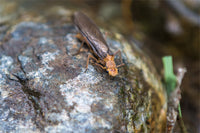
How to Build a Trophy Trout Water
As fly fishers, we all share the unifying dream of one day owning our own little piece of fly fishing heaven! A section of river where you don't need to compete for for water, and familiarity allows you to approach a pool knowing that you have a good chance of hooking that 24" brown trout that likes to hold in the seam just left of the log. Whether this is your present reality or a dream that you will hold until retirement or you hit the lottery, it is important to remember that the shrewd investor always does their homework. Regardless to if you are looking to purchase equity in a hot new start-up or a picturesque ranch with a spring creek meandering through its heart, being able to identify strengths, hidden potential, and foundational weakness will make the difference between buying a lemon and a valuable asset. The purchase of a recreational property or piece of live-water is no different. The cornerstones upon which a trophy trout fishery is built are: 1) cool, clean water; 2) quality, abundant forage; and 3) diverse in-stream habitat that can weather the highs and lows that Mother Nature throws at it.
Similar to hiring a home inspector to dive into a crawl space and check for exposed wires before a home purchase, contracting an environmental consultant comprised of a diverse group of biologists, ecologists, and engineers will allow you to thoroughly measure the health and sporting potential of a fishing property. For those who are not ready to commit to an in-depth assessment however, there are a couple cues and clues that you can look for in the field that will tell you that you may have found your piece of fishing gold!
Know Your Neighbors
A river or lake is a living entity, intimately tied and entwined with the health of the land both upstream and on either bank. How the land around a target property is used and has been managed in the past will directly affect the health and overall potential of the fishery. If there are abandoned mines or unimpeded cattle access upstream of your property, that can affect the water quality and negatively impact fish habitat. Does your potential purchase abut a fishing club or flow from a protected wilderness area? This can bode well for the quality of water as it enters your property, while providing a tangible picture of the habitat and sporting potential that can be attained.
The Bugs Talk
When walking the banks of a potential water purchase, it pays to get your feet wet. Reach into the water and pull rocks from the flow to see what is creeping and crawling on their surfaces. Shake the branches of stream-side willows to see what types of bugs are scared into flight. Take a peek at lakeside spider webs to observe the types of bugs that have recently hatched. The presence of a diverse and abundant population of mayflies, stoneflies, and caddis flies is an indicator of good water quality (the quality of water in which trout can thrive). These specific families of invertebrates are also among trout's favorite foods, and their abundance will play a vital role in supporting a healthy, self-sustaining fishery.
Follow Mother Nature's Blueprint
Trout thrive and can reach trophy proportions when they have access to a diversity of quality habitat. A natural progression of cascading riffles, braided side channels, deep pools, and in-stream cover are essential to the support of a balanced, healthy population of trout. If a stream is dominated by beaver ponds or an unbroken progression of riffles, trout may be missing adequate spawning ground or refuge from seasonal changes in water levels, both of which will limit the quality of the fishery. As you walk a property, look for the progression of riffle, run, & pool modeled in nature, which is proven to meet the diverse needs of trout.
When it comes right down to it, every piece of live water has potential. Under a guiding hand, the flow of the river can be trained and focused to open up long forgotten habitat. Mayfly and stonefly nymphs will return to crawl among newly restored riffles, and caddis will perch upon freshly planted willow stakes. The only questions that remain are which fishing property is right for you, and which dry fly do you tie on to catch those brown trout rising to an evening hatch on your own piece of fly fishing heaven!
If you own a section of river or a lake and would like to assess its trophy fishery potential, please click here to email me and discuss the possibility of having a team of biologists, ecologists, and engineers from Ecological Resource Consultants assess your water.




